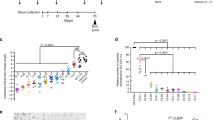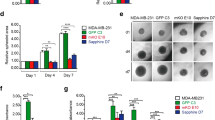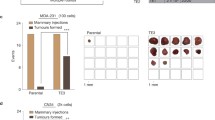Summary
In previous experiments it was shown that injection into syngeneic CBA/J mice of cell mixtures containing an excess of non-metastatic SP1 mouse mammary carcinoma cells with aras transfected metastatic variant of SP1 called C1, always resulted in the eventual dominance of the C1 subpopulation at the site of inoculation. This occurred despite the growth rates of the two cell populations being identical in vivo when grown separately. The means by which the C1 subpopulation achieved “clonal dominance” is thought to involve its responsiveness to stimulatory paracrine growth factors liberated by the non-metastatic SP1 population. The clonal dominance process, however, could not be recapitulated in conventional monolayer tissue culture conditions in which SP1 and C1 cells were grown together in high concentrations of serum, i.e. under non-limiting culture conditions. We now show that clonal dominance of C1 cells can be observed when the cell mixture is maintained in tissue culture for extended periods, or when the cells are grown under selective, limiting conditions, some of which may mimic growth conditions in vivo more accurately. These conditions were a) growth in low (limiting) serum concentrations; and b) growth as three-dimensional multicellular aggregates, i.e. as “tumor spheroids”. Under all of these conditions dominance of the C1 subpopulation always took place, but with an efficiency 6- to 40-fold less than generally observed in vivo. C1 cells were also able to form more stable (compact) spheroids compared to SP1 cells. Entrapment of the latter in mixed C1/SP1 spheroids increased the recovery of the SP1 cells suggesting some kind of “rescue” mechanism in which cells are protected from physical forces by three-dimensional structure. The relevance of these in vitro interactions for clonal dominance in primary tumors and metastasis in vivo are discussed.
Similar content being viewed by others
References
Bell, C.; Frost, P.; Kerbel, R. S. Cytogenetic heterogeneity of genetically marked and metastatically competent “dominant” tumor cell clones. Cancer Genet. Cytogenet. 54:153–161; 1991.
Enoki, Y.; Niwa, O.; Yokoro, K., et al. Analysis of clonal evolution in a tumor consisting of pSV2neo-transfected mouse fibrosarcoma cells. Jpn. J. Cancer Res. 81:141–147; 1990.
Gorelik, E.; Beere, W. W.; Herberman, R. B. Role of the NK cells in the anti-metastatic effect of anti-coagulant drug. Int. J. Cancer 33:87; 1984.
Herlyn, M. Human melanoma: development and progression. Cancer Metastasis Rev. 9:101–112; 1990.
Huang, H.-J. S.; Yee, J.-K.; Shew, J.-Y., et al. Suppression of the neoplastic phenotype by replacement of the RB gene in human cancer cells. Science 242:1563–1566; 1988.
Johnson, J. P.; Stade, B. G.; Holzmann, B., et al. De novo expression of intercellular adhesion molecule 1 in melanoma correlates with increased risk of metastasis. Proc. Natl. Acad. Sci. USA 86:641–644; 1989.
Kath, R.; Rodeck, U.; Parmiter, A., et al. Growth factor independence in vitro of primary melanoma cells from advanced but not early or intermediate lesions. Cancer Ther. Control 1:179–191; 1991.
Kerbel, R. S. Growth dominance of the metastatic cancer cell: cellular and molecular aspects. Adv. Cancer Res. 55:87–132; 1990.
Kerbel, R. S. Expression of multi-cytokine resistance and multi-growth factor independence in advanced stage metastatic cancer: malignant melanoma as a paradigm. Am. J. Pathol. 141:519–524; 1992.
Kerbel, R. S.; Cornil, I.; Korczak, B. New insights into the evolutionary growth of tumors revealed by Southern gel analysis of tumors genetically tagged with plasmid or proviral DNA insertions. J. Cell Sci. 94:381–387; 1989.
Kerbel, R. S.; Waghorne, C.; Korczak, B., et al. Clonal changes in tumors during growth and progression evaluated by Southern gel analysis of random integrations of foreign DNA. CIBA Found. Symp. 141:123–148; 1988.
Kerbel, R. S.; Waghorne, C.; Korczak, B., et al. Clonal dominance of primary tumors by metastatic cells: genetic analysis and biological implications. Cancer Surv. 7:597–629; 1988.
Korczak, B.; Robson, I. B.; Lamarche, C., et al. Genetic tagging of tumor cells with retrovirus vectors: clonal analysis of tumor growth and metastasis in vivo. Mol. Cell. Biol. 8:3143–3149; 1988.
Laderoute, K. R.; Murphy, B. J.; Short, S. M., et al. Enhancement of transforming growth factor-α synthesis in multicellular tumor spheroids of A431 squamous carcinoma cells. Br. J. Cancer 65:157–162; 1992.
Lu, C.; Vickers, M. F.; Kerbel, R. S. Interleukin-6: a fibroblast-derived growth inhibitor of human melanoma cells from early but not advanced stages of tumor progression Proc. Natl. Acad. Sci. USA 89:9215–9219; 1992.
Miller, B. E.; Miller, F. R.; Wilburn, D., et al. Dominance of a mammary tumor subpopulation in mixed heteogenous tumors. Cancer Res. 48:5747–5753; 1988.
Miller, F. R.; Heppner, G. H. Cellular interactions in metastasis. Cancer Metastasis Rev. 9:21–34; 1990.
Moffett, B. F.; Babau, D.; Bao, L., et al. Fate of clonal lineages during neoplasia and metastasis studied with an incorporated genetic marker. Cancer Res. 52:1737–1743; 1992.
Offner, F. A.; Wirtz, H. C.; Schiefer, J., et al. Interaction of human malignant melanoma (ST-ML-12) tumor spheroids with endothelial cell monolayers. Am. J. Pathol. 141:601–610; 1992.
Price, J. E.; Bell, C.; Frost, P. The use of a genotypic marker to demonstrate clonal dominance during the growth and metastasis of a human breast carcinoma in nude mice. Int. J. Cancer 45:968–971; 1990.
Radinsky, R.; Kraemer, P. M.; Proffitt, M. R., et al. Clonal diversity of the Kirsten-ras oncogene during tumor progression in athymic nude mice: mechanisms of amplification and rearrangement. Cancer Res. 48:4941–4953; 1988.
Rak, J. W.; Hegmann, E. J.; Kerbel, R. S. The role of angiogenesis in tumor progression and metastasis. In: Heppner, G. H., ed. Molecular biology of a cancer cell. Greenwich, CT: JAI Press, Inc; 1992:in press.
Rodeck, U.; Herlyn, M.; Menssen, D., et al. Metastatic but not primary melanoma cell lines grow in vitro independently of exogenous growth factors. Int. J. Cancer 40:687–690; 1987.
Rofstad, E. K.; Wahl, A.; Davies, C., et al. Growth characteristics of human melanoma multicellular spheroids in liquid-overlay culture: comparisons with the parent tumour xenografts. Cell Tissue Kinet. 19:205–216; 1986.
Samiei, M.; Waghorne, C. G. Clonal selection within metastatic SP1 mouse mammary tumors is independent of metastatic potential. Int. J. Cancer 47:771–775; 1991.
Sasaki, T.; Yamamoto, M.; Yamaguchi, T., et al. Development of multicellular spheroids of HeLa cells cocultured with fibroblasts and their response to X-irradiation. Cancer Res. 44:345–351; 1984.
Schipper, J. H.; Frixen, U. H.; Behrens, J., et al. E-cadherin expression in squamous cell carcinomas of head and neck: inverse correlation with tumor differentiation and lymph node metastasis. Cancer Res. 51:6328–6337; 1991.
Sidransky, D.; Mikkelsen, T.; Schwechheimer, K., et al. Clonal expansion of p53 mutant cells is associated with brain tumour progression. Nature 355:846; 1992.
Staroselsky, A. N.; Radinsky, R.; Fidler, I. J., et al. The use of molecular genetic markers to demonstrate the effect of organ environment on clonal dominance in a human renal-cell carcinoma grown in nude mice. Int. J. Cancer 51:130–138; 1992.
Sutherland, R. M. Cell and environment interactions in tumor microregions: the multicell spheroid model. Science 240:177–184; 1988.
Sutherland, R. M.; Durand, R. E. Growth and characteristics of multicell spheroids. In: Ackner, H.; Carlsson, J.; Durand, R., et al., eds. Spheroids in cancer research. New York: Springer Verlag; 1984:24–50.
Takahashi, R.; Hashimoto, T.; Xu, H.-J., et al. The retinoblastoma gene functions as a growth and tumor suppressor in human bladder carcinoma cells. Proc. Natl. Acad. Sci. USA 88:5257–5261; 1991.
Takezawa, T.; Yamazaki, K.; Mori, Y., et al. Morphological and immuno-cytodiencial characterization of a hetero-spheroid composed of fibroblasts and hepatocytes. J. Cell Sci. 101:495–501; 1992.
Theodorescu, D.; Caltabiano, M.; Greig, R., et al. Reduction of TGF-beta activity abrogates growth promoting tumor cell-cell interactions in vivo. J. Cell Physiol. 148:380–390; 1991.
Theodorescu, D.; Cornil, I.; Sheehan, C., et al. Dominance of metastatically competent cells in primary murine breast neoplasms is necessary for distant metastatic spread. Int. J. Cancer 47:118–123; 1991.
Theodorescu, D.; Sheehan, C.; Kerbel, R. S. Tumor cells grown as monolayers or multicellular spheroids indicate autoregulation of TGF-β gene expression is dependent on tissue architecture. In Vitro Cell. Dev. Biol. In press; 1992.
Tofilon, P. J.; Buckley, N.; Deen, D. F. Effect of cell-cell interactions on drug sensitivity and growth of drug-sensitive and -resistant tumor cells in spheroids. Science 226:862–864; 1984.
Waghorne, C.; Kerbel, R. S.; Breitman, M. L. Metastatic potential of SP1 mouse mammary adenocarcinoma cells is differentially induced by activated and normal forms of h-H-ras. Oncogene 1:149–155; 1987.
Waghorne, C.; Thomas, M.; Lagarde, A. E., et al. Genetic evidence for progressive selection and overgrowth of primary tumors by metastatic cell subpopulations. Cancer Res. 48:6109–6114; 1988.
Weiss, L. Metastatic inefficiency. Adv. Cancer Res. 54:159–211; 1990.
Author information
Authors and Affiliations
Rights and permissions
About this article
Cite this article
Rak, J.W., Kerbel, R.S. Growth advantage (“clonal dominance”) of metastatically competent tumor cell variants expressed under selective two- or three-dimensional tissue culture conditions. In Vitro Cell Dev Biol - Animal 29, 742–748 (1993). https://doi.org/10.1007/BF02631431
Received:
Accepted:
Issue Date:
DOI: https://doi.org/10.1007/BF02631431




